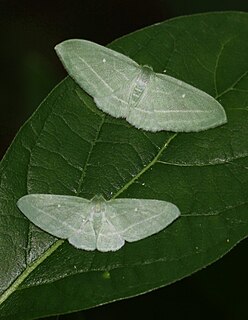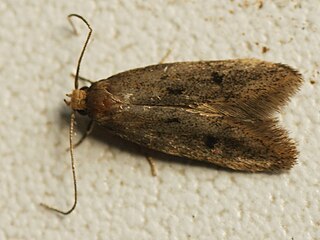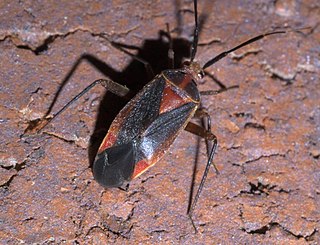
Pentatomidae is a family of insects belonging to the order Hemiptera, generally called shield bugs or stink bugs. Pentatomidae is the largest family in the superfamily Pentatomoidea, and contains around 900 genera and over 4700 species. As hemipterans, the pentatomids have piercing sucking mouthparts, and most are phytophagous, including several species which are severe pests on agricultural crops. However, some species, particularly in the subfamily Asopinae, are predatory and may be considered beneficial.

Gelechioidea is the superfamily of moths that contains the case-bearers, twirler moths, and relatives, also simply called curved-horn moths or gelechioid moths. It is a large and poorly understood '"micromoth" superfamily, constituting one of the basal lineages of the Ditrysia.

Ranatra is a genus of slender predatory insects of the family Nepidae, known as water scorpions or water stick-insects. There are around 100 Ranatra species found in freshwater habitats around the world, both in warm and temperate regions, with the highest diversity in South America and Asia. Fewer are found elsewhere, but include several African, some in North America, three from Australia and three from the Palearctic, notably the relatively well-known European R. linearis.

Catoptria is a genus of moths of the family Crambidae.
Pompeja is a monotypic moth genus in the family Lasiocampidae erected by Gottlieb August Wilhelm Herrich-Schäffer in 1856. Its only species, Pompeja psorica, described by the same author two years earlier, is found in Brazil.

Dyspteris is a monotypic moth genus in the family Geometridae erected by Jacob Hübner in 1818 found in North America. Its only species, Dyspteris abortivaria, the bad-wing, was first described by Gottlieb August Wilhelm Herrich-Schäffer in 1855. It is called "bad-wing" because its forewing is much larger than its hindwing, making it often difficult to pull into position for spreading.

Harpactor is a genus of assassin bug family (Reduviidae), in the subfamily Harpactorinae.

Euagoras is a genus of assassin bugs, in the subfamily Harpactorinae. Species are found in Asia and Australia.

Phylinae is a subfamily of insects in the family Miridae, the plant bugs.

Borkhausenia luridicomella is a moth of the family Oecophoridae. It was described by Gottlieb August Wilhelm Herrich-Schäffer in 1856. It is found from Scandinavia south to Italy and Romania and from the Benelux, Germany and Switzerland east to Russia.

Bryocorinae is a subfamily of bugs in the family Miridae.

Taedia is a genus of plant bugs in the family Miridae. There are more than 80 described species in Taedia.

Mozena is a genus of leaf-footed bugs in the family Coreidae. There are more than 30 described species in Mozena.
Miresa albipuncta is a moth of the family Limacodidae first described by Gottlieb August Wilhelm Herrich-Schäffer in 1854. It is found in Sri Lanka, India and Nepal.

Celypha capreolana is a moth belonging to the family Tortricidae.
Epinotia granitana is a moth belonging to the family Tortricidae. The species was first described by Gottlieb August Wilhelm Herrich-Schäffer in 1851.
Eucosma albidulana is a moth belonging to the family Tortricidae. The species was first described by Gottlieb August Wilhelm Herrich-Schäffer in 1851.
Eucosma lacteana is a moth belonging to the family Tortricidae. The species was first described by Treitschke in 1835.

Perizoma lugdunaria is a moth belonging to the family Geometridae. The species was first described by Gottlieb August Wilhelm Herrich-Schäffer in 1885.













